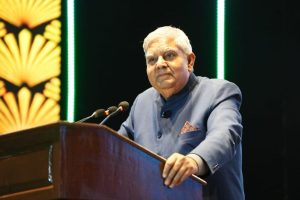The ghost of rechristening Shimla as Shyamala has yet again been laid to rest with Chief Minister Jai Ram Thakur abandoning the proposal.
The issue of name change was raked up once again by the right-wing Vishwa Hindu Parishad (VHP). Launching into campaign mode, they submitted a proposal to the state government, justifying the suggestion as an attempt to remove the signs and symbols of British rule.
Before the Britishers touched the soil of Shimla, it was known as ‘Shyamala’ deriving its name from Shyamala Devi, a venerated goddess of the locals known to be an avatar of Goddess Kali, they claimed.
Media reports highlighted the issue after the Chief Minister’s statement that he would give thought to the proposal subject to public opinion. Even one of his cabinet ministers found no harm in reverting to the old name, as was being done to cities in other parts of the country, a recent example being the decision to change Allahabad to Prayagraj, by the Uttar Pradesh government.
The move to change Shimla’s name created a flutter on social media and there were angruy responses from the public. Much to the disappointment of the VHP, there were very few supporters for the proposal.
The opposition parties and the general public sought to know the justification for the move and found no merit in it. Some argued that a different name would change the character of the city that is already famous globally. Steeped in history a name change could alter the very character of the city.
People also highlighted that a mere name change could in no way help to address the problems of Shimla and the need to aspire to global standards to attract tourists, owing to colonial past. Shimla had been adopted as a summer capital by the Britishers in 1864 and continued to be that till the country got independence from colonial rule in 1947.
The days of the British Raj are still visible in the architecture, names of places, around 91 British-era heritage buildings, the famous heritage Shimla-Kalka Railway line, first water supply scheme (1875) which still supplies water to Shimla and even some top British era educational institutions and many more, which are hard to wipe out, with a mere name change.
The VHP had also wanted Peterhoff, the state tourism department, to be named Valmiki Bhawan after sage Valmiki. Peterhoff had served as the residence of governor generals and viceroys during the British Raj days. Post Independence it housed the Punjab High Court where Nathu Ram Godse had faced trial for assassinating Mahatma Gandhi. Other name changes demanded included Dalhousie established in 1854 by the British government as a summer retreat to be named after revolutionary and freedom fighter Subhash Chandra Bose.
The VHP also wants Nurpur town to be named after Wazir Ram Singh Pathania hailed as the first freedom fighter of the country.
The proposal had it been accepted could have thrown open the Pandora’s Box, escalating more demands from other corners. The Herculean task of changing names would have ensued involving a huge burden on the state exchequer to rid the state of its colonial shadow.
In 2016 as well, right-wing parties had submitted a similar proposal to the then Congress government headed by Virbhadra Singh. He had outright turned down the proposal.
The Opposition Congress has now cautioned the state government against any change of name warning that they will take to the streets. The Communist Party of India (Marxist) also objected to the proposal.
Virbhadra Singh termed the move absurd. “Tomorrow what if they will ask for renaming Virbhadra Singh or even renaming Chief Minister Jai Ram Thakur,” he quipped.










